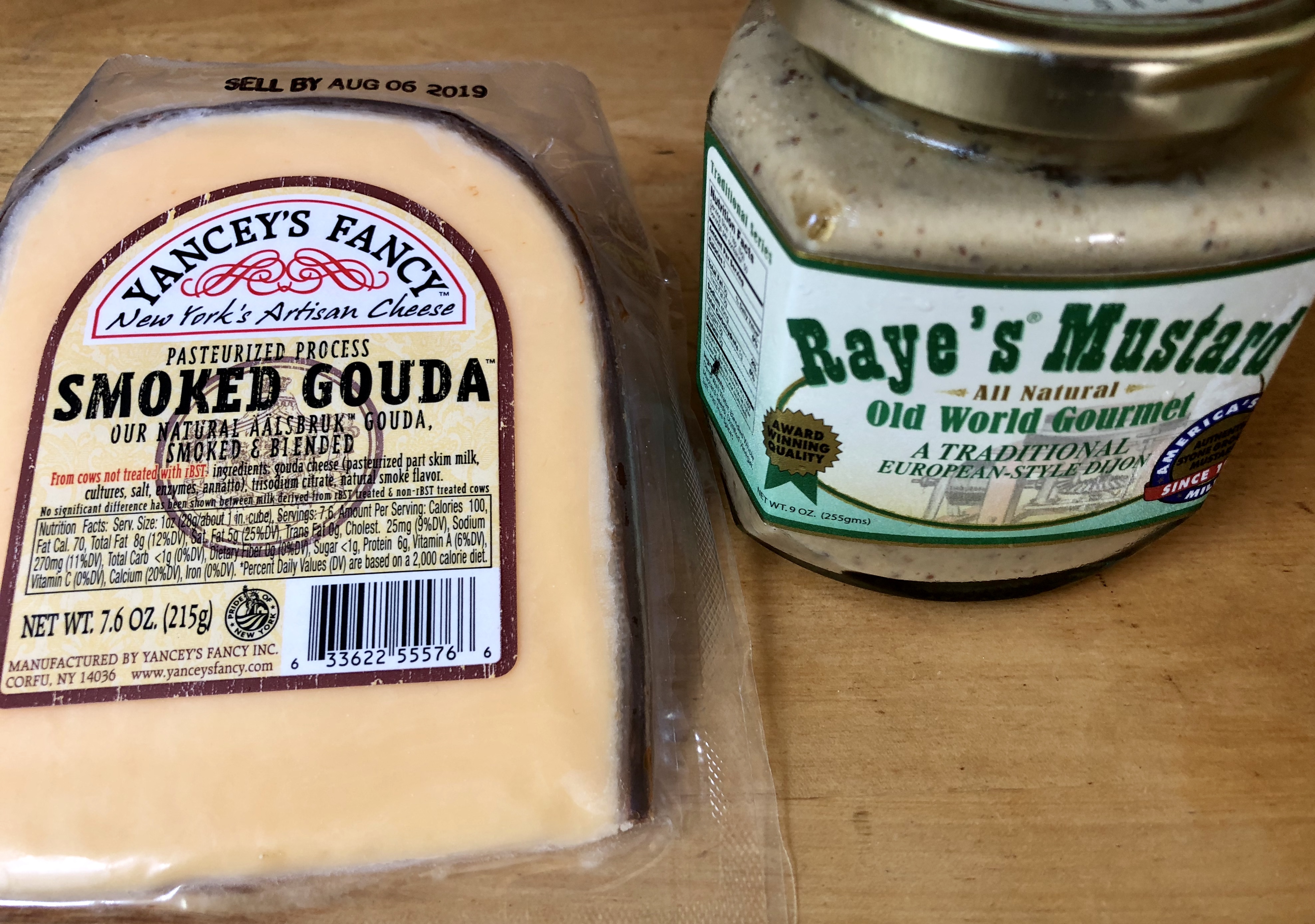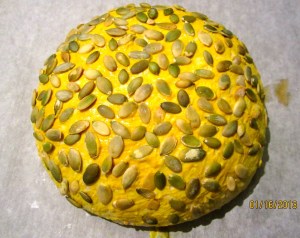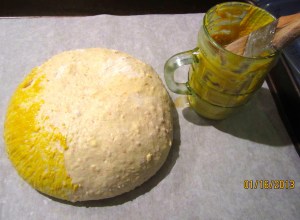Hier geht’s zur deutschen Version dieses Posts
Several years ago, a FB friend and baking buddy, David Wolfe, asked me to help him with a German recipe. Alas, Google Translate is not too fluent in professional German baking lingo.
The formula, published by a German bakers’ association, seemed quite intriguing, combining rye meal and cracked wheat with mustard and cheese. The amounts, of course, were calculated for a commercial bakery, as were the sparse instructions. I had to downsize the formula to home baking proportions.
The breads are baked “bei Brötchentemperatur” (“at roll temperature”) – leaving the hapless hobby baker clueless as to what that might be. Fortunately, a quick search at the German Wikipedia site showed me the light: the breads had to be baked at 465ºF/240ºC.
A friend of slow fermentation (also from a physician’s point of view), I re-wrote the procedure, from using just a small amount of pre-fermented flour, to preferment plus soaker (for the coarser grinds), as well as a long, cold fermentation of the dough.
The recipe lets you choose between Gouda or Tilsiter. I don’t care for stinky cheeses (unlike the US version, German Tilsiter is smelly), so I opted for middle-aged Dutch, not too mild, but not too assertive, either, and used a medium-hot yellow mustard from Düsseldorf.
I was very pleased with the result, a beautiful red golden bread, with a stunning, almost neon-yellow crumb. Pleasantly spicy (but not too much), it tasted great with cold cuts, and was a nice surprise when toasted: a bread with built-in grilled cheese!

Though I had always intended to bake this amazing loaf again, I never got around to it (so much to bake – so little time!), until I received an email from food historian, lecturer and author Demet Güzey. The Senfbrot had caught her eye, as she was doing research on mustard.
Taking this a sign from above, I revisited the formula, trying it with different kinds of cheese and mustard. I, also, substituted the preferment with a sourdough starter, and reduced the yeast in the final dough even more (down to 1/3 of the original recipe amount!)
If you prefer a more assertive taste of cheese, you can choose a sharper one. For me, a version made with sharp cheddar was a bit too much.


SENFBROT – MUSTARD BREAD (2 loaves)
(adapted from BÄKO Gruppe Nord)
Starter
40 g/ 1.4 oz wheat starter (100%)
64 g/2.2 oz water
126 g/4.4 oz bread flour
Soaker
104 g/3.7 oz cracked wheat (coarse meal)
70 g/2.5 oz rye meal
130 g/4.4 oz water
2 g/0.12 oz salt
Final Dough
230 g/8.1 oz starter (all)
306 g/10.8 oz soaker (all)
558 g/19.7 oz bread flour
4 g/0.14 oz instant yeast (original recipe: 15 g/0.5 oz)
16 g/0.6 oz salt
408 g/14.3 oz water
66 g/2.3 oz mustard
122 g/4.3 oz middle aged Gouda*), coarsely grated
2 tbsp mustard, mixed with 1 tsp water, for brushing
sunflower or pumpkin seeds, for topping
*) Or a milder or sharper cheese, to taste

DAY 1:
In the morning, mix starter and soaker. Cover bowls, and leave at room temperature for about 6 – 8 hours, until starter is visibly puffed.
For the final dough, mix all ingredients at low speed for 1-2 minutes, until all flour is hydrated. Let dough rest for 5 minutes, then knead at medium-low speed for 6 minutes. Dough will be rather sticky, clearing only sides of bowl (somewhat), but stick to bottom. (If you are not used to handling rather sticky dough, you can adjust with a small amount of flour).

Transfer dough to a lightly oiled bowl. With wet hands, stretch and fold dough over from all 4 sides (with very sticky dough this works better in the bowl than on the work bench).
Cover, and let dough rest for 10 minutes. Repeat stretching and folding 4 more times at 10 minute intervals. (With a less sticky dough this can be done on an oiled work bench.)

(At this point I already divide my dough in halves for the 2 breads, and put them in separate containers.) After the last fold, place dough in refrigerator overnight.

DAY 2:
Remove dough from fridge 2 hours before using.
Preheat oven to 465ºF/240ºC, including baking stone and steam pan. Line baking sheet with parchment paper. Keep mustard and seeds for topping at hand.

Shape dough into 2 boules, and place on prepared baking sheet. Brush with mustard, and sprinkle with seeds, pressing them a bit down with your hands to stick.

Place breads, seam side down, on parchment lined baking sheet, and proof, covered, for 45 – 60 minutes, or until they have grown 1 1/2 times their original size.

Bake loaves for 15 minutes, steaming with 1 cup of boiling water. Remove steam pan, and rotate breads 180 degrees.
Reduce temperature to 210ºC/410ºF, and continue baking for another 25 minutes, or until breads are a deep reddish (or golden brown – depending on the mustard), sound hollow when thumped at the bottom, and register at least 200ºF/93ºC.
Let breads cool on a wire rack.


Updated and re-written post from an earlier one, published in 2013 (and submitted to YeastSpotting)

I remember this bread! It was delicious. The crumb in the updated loaf looks wonderful! I’ll have to try the updated formula!
LikeLike
I think when I made it the first time, I, also, adjusted with a bit more flour, since I was not used to handling stickier doughs.
LikeLike
klasse, Senf und Käse hatte ich heute zum Frühstück- auf dem Brot. Das werd ich bestimmt nachbacken!
LikeLike
Und beides schmeckt nicht vor, sondern verleiht nur eine angenehme Würze.
LikeLiked by 1 person
Love this recipe!
LikeLike
Thanks! Me, too 😊
LikeLiked by 1 person
This looks like a delicious recipe! So unique and unlike any I have tried before. Nice job!
LikeLike
I thought so, too. Thanks, Diane!
LikeLiked by 1 person
I love German food! And that looks superb!
LikeLike
Thanks! I’m glad you do.
Today I made this bread with a sourdough starter. It worked very well, too, and I will include that in my post.
LikeLiked by 1 person
Looks even better now with the natural starter. Perfect Octoberfest bread!
LikeLike
Yes!!!
LikeLiked by 1 person
Good Christmas morning. I tried posting a question (I guess it was on your old site which I found while searching the web for flour.). I use weizenmehl Glattes 700 (is what it says on the package) to make my palatschinken. I generally buy the flour when I visit my family in Austria. I have had absolutely no fails when making them with this flour, and I’d like to find some or it’s equivalent here in the states. I do have some left but it is past the date on the package. I don’t think that matters as I keep it in the refrigerator and it made wonderful palatschinken this morning. Any help in my search would be most appreciated.
LikeLike
Hi, Shirley, unfortunately I had to migrate my blog since blogspot wasn’t supported on newer devices anymore. You can substitute Austrian 700 Weizenmehl with US all-purpose flour, it has about the same protein/gluten content. „Glatt“ means fine flour and not „griffig“ (a bit coarser ground).
If it would only say “glattes Mehl” on your package, without the type number 700, it would be the equivalent of US cake flour, with much lower protein. But since you enrich the batter with eggs, milk and butter, it will not make a big difference which flour you use, since all that dairy makes the dough soft, anyway.
White flour basically keeps forever, you don’t even have to store it in the fridge (unlike whole grain flours).
For more ingredient “translations”, check out my other posts on the Pantry page.
Merry Christmas to you and your family, too,
Karin
LikeLike
Hi Karin and Happy New Year. I have arrived at your site via Karen’s Back Road Journal blog and glad to have found you. If it’s any consolation, Google translate is near worthless with Swedish to English recipe translating as well.
I love baking bread and enjoy a challenging loaf and this one has a high level of challenge for me, so I’ve got to try this one. Keep the recipes coming.
LikeLike
Happy New Year to you, too, and thanks for visiting, Ron! Yes, I can imagine Google’s translation skills are no better for Swedish. My New Year’s resolution: overcome my laziness and write more posts!
LikeLike
Hey Karin, how is it going? You know that there is some types of leavening give better flavour to the mustard sauce than the others, knowing that I need to know what is one of the best leavenings to do mustard sauce, if not the best one.
LikeLike
Davi, I’m not quite sure what you mean.
LikeLike
I talking about the type of leavening to ferment the mustard grains
For a homemade mustard sauce instead of a bought one, got it?
LikeLike
This bread contains store-bought mustard, not mustard grains or mustard sauce.
LikeLike
I know, just asking, because I saw some people doing it in commentaries! Correcting, yeast and probiotics*!
LikeLike
I’m happy to answer all questions I know the answer for. I sometimes use mustard seeds in Indian dishes, and prepare a mustard sauce for a German dish with hard boiled eggs.
LikeLike